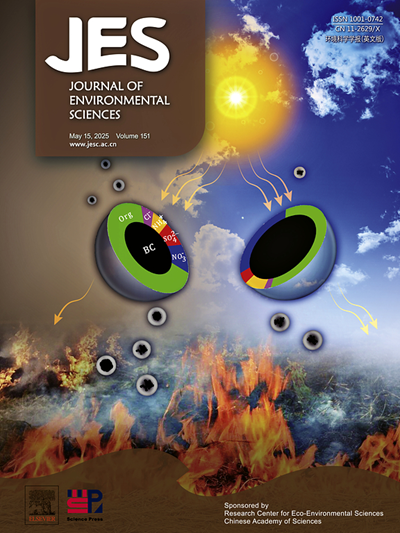Water-soluble organic nitrogen in PM2.5 around the Danjiangkou Reservoir: Concentration, sources, and transport pathways
IF 6.3
2区 环境科学与生态学
Q1 ENVIRONMENTAL SCIENCES
引用次数: 0
Abstract
Water-soluble organic nitrogen (WSON) affects the formation, hygroscopicity, acidity of organic aerosols, and nitrogen biogeochemical cycles. However, qualitative and quantitative characterizations of WSON remain limited due to its chemical complexity. In the study, 1-year field samples of particulate matter 2.5 (PM2.5) were collected from June 2022 to May 2023 to analyze the WSON concentration in PM2.5, and correlation analysis, positive matrix factor (PMF), and potential source contribution function (PSCF) models were employed to elucidate WSON source apportionment and transport pathways. The results revealed that the mean WSON concentrations reached 1.98 ± 2.64 µg/m³ with a mean WSON to water-soluble total nitrogen (WSTN) ratio of 21 %. Further, WSON concentration exhibited a seasonal variation trend, with higher values in winter and lower in summer. Five sources were identified as contributors to WSON in PM2.5 within the reservoir area through a comprehensive analysis including correlation analysis, PSCF and concentration weighted trajectory (CWT), and PMF analyses. These sources were agricultural, dust, combustion, traffic, and industrial sources, of which agricultural source emerged as the primary contributor (76.69 %). The atmosphere in the reservoir area were primarily influenced by the transport of northeastern air masses, local agricultural activities, industrial cities along the trajectory, and coastal regions, exerting significant influences on the concentration of WSON in the reservoir area. The findings of this study addressed the research gap concerning organic nitrogen in PM2.5 within the reservoir area, thereby offering a theoretical foundation and data support in controlling nitrogen pollution in the Danjiangkou Reservoir area.

丹江口水库周边PM2.5中水溶性有机氮的浓度、来源及转运途径
水溶性有机氮(WSON)影响有机气溶胶的形成、吸湿性、酸度和氮的生物地球化学循环。然而,由于其化学性质的复杂性,对WSON的定性和定量表征仍然有限。本研究选取2022年6月至2023年5月1年的PM2.5野外样本,分析PM2.5中WSON浓度,并采用相关分析、正矩阵因子(PMF)和潜在源贡献函数(PSCF)模型阐明WSON源分配和输送途径。结果表明,平均WSON浓度为1.98±2.64µg/m³,平均WSON与水溶性总氮(WSTN)之比为21%。WSON浓度呈冬季高夏季低的季节变化趋势。通过相关分析、PSCF和浓度加权轨迹(CWT)、PMF分析等综合分析,确定了库区PM2.5 WSON的5个来源。农业、扬尘、燃烧、交通和工业是主要的污染源,其中农业污染源最多(76.69%)。库区大气主要受东北气团输送、当地农业活动、轨迹沿线工业城市和沿海地区的影响,对库区WSON浓度有显著影响。本研究结果弥补了库区PM2.5有机氮的研究空白,为丹江口库区氮素污染治理提供理论基础和数据支持。
本文章由计算机程序翻译,如有差异,请以英文原文为准。
求助全文
约1分钟内获得全文
求助全文
来源期刊

Journal of Environmental Sciences-china
环境科学-环境科学
CiteScore
13.70
自引率
0.00%
发文量
6354
审稿时长
2.6 months
期刊介绍:
The Journal of Environmental Sciences is an international journal started in 1989. The journal is devoted to publish original, peer-reviewed research papers on main aspects of environmental sciences, such as environmental chemistry, environmental biology, ecology, geosciences and environmental physics. Appropriate subjects include basic and applied research on atmospheric, terrestrial and aquatic environments, pollution control and abatement technology, conservation of natural resources, environmental health and toxicology. Announcements of international environmental science meetings and other recent information are also included.
 求助内容:
求助内容: 应助结果提醒方式:
应助结果提醒方式:


